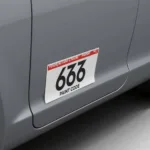Faded and peeling paint isn’t just an eyesore; it can significantly decrease your car’s value and expose the metal underneath to rust and corrosion. Knowing how to repair faded peeling paint on car is essential for maintaining its appearance and longevity. This guide provides a comprehensive walkthrough, from diagnosing the problem to achieving a professional-looking finish.
Repairing faded and peeling car paint is a multi-step process that requires patience and attention to detail. But with the right tools and techniques, you can restore your car’s finish to its former glory. You can learn more about fixing faded car paint at car paint faded repair.
Identifying the Cause of Fading and Peeling Paint
Before diving into the repair process, it’s crucial to identify the root cause of the problem. Is it sun damage, oxidation, improper washing techniques, or something else? Pinpointing the cause will help you choose the appropriate repair method and prevent the issue from recurring. Common culprits include prolonged exposure to UV rays, acidic bird droppings, harsh car wash chemicals, and environmental contaminants.
Common Culprits of Paint Damage
- Sun Damage: The UV rays from the sun break down the chemical bonds in the paint, leading to fading and cracking. This is especially prevalent in clear coats. For more on sun damage repair, visit repair car paint sun damage.
- Oxidation: This chemical reaction occurs when the paint is exposed to oxygen and moisture, causing it to dull and lose its shine.
- Improper Washing Techniques: Using abrasive cleaners, harsh sponges, or automated car washes with stiff brushes can scratch and damage the paint, making it more susceptible to fading and peeling.
Gathering the Necessary Tools and Materials
Once you’ve identified the cause, gather the necessary tools and materials. This typically includes sandpaper (various grits), masking tape, primer, paint (matched to your car’s color), clear coat, polishing compound, and wax. Having everything on hand will streamline the repair process.
Preparing the Affected Area
Thoroughly wash and dry the affected area. Then, using sandpaper, carefully sand down the peeling paint until you reach a smooth, even surface. This step is crucial for proper adhesion of the new paint layers. Remember to use progressively finer grits of sandpaper to minimize scratches.
Priming, Painting, and Clear Coating
Apply a thin, even coat of primer to the sanded area. Once dry, apply several thin coats of paint, allowing each coat to dry before applying the next. Finish with a clear coat for protection and shine. Learn more about clear coat repair at car clear coat paint repair.
Applying the Paint Like a Pro
- Thin Coats are Key: Applying multiple thin coats is better than one thick coat, as it prevents runs and ensures even coverage.
- Proper Drying Time: Allow each coat to dry completely before applying the next to avoid trapping solvents and compromising the finish.
Finishing Touches: Polishing and Waxing
After the clear coat has cured, polish the repaired area to remove any imperfections and blend it seamlessly with the surrounding paint. Finally, apply a coat of wax to protect the newly repaired paint and enhance its shine. Consider visiting repair sun damaged car paint for more detailed information on addressing sun-related paint issues. You might also find helpful tips on how to repair car paint sun damage.
Conclusion
Repairing faded and peeling paint on your car might seem daunting, but by following these steps and exercising patience, you can achieve professional-looking results and restore your car’s appearance. Addressing this issue promptly will not only improve your car’s aesthetics but also protect it from further damage.
FAQ
- How long does it take for the paint to cure completely? The curing time varies depending on the type of paint and environmental conditions, but it typically takes a few days to a week.
- Can I repair faded paint without repainting? Minor fading can sometimes be addressed with polishing and waxing, but peeling paint requires repainting.
- What is the best type of paint to use for car repairs? Automotive acrylic lacquer or acrylic urethane paints are commonly used for car repairs due to their durability and colorfastness.
- How can I prevent my car’s paint from fading and peeling in the future? Regularly washing and waxing your car, parking in the shade, and using a car cover can help protect the paint.
- What should I do if the peeling paint is extensive? If the damage is widespread, it’s best to consult a professional auto body shop.
- Can I use touch-up paint for peeling paint? Touch-up paint is suitable for small chips and scratches, but not for large areas of peeling paint.
- Do I need to prime the area before repainting? Yes, primer is essential for proper paint adhesion and a smooth, even finish.
More Help and Resources
For more information on car repair and maintenance, you can explore other articles on our website. If you’re having trouble diagnosing a specific car problem, our expert team is always ready to assist.
Need help? Contact us via WhatsApp: +1(641)206-8880, Email: [email protected]. Our customer support team is available 24/7.

